Ancient Civilizations of Rajasthan form the foundation of the state’s historical development and cultural heritage. In the study of Rajasthan History, these civilizations span from the Palaeolithic, Mesolithic, and Neolithic periods to the Bronze and Iron Ages. Important sites such as Kalibangan, Gilund, Ahar, Ojiyana, Balathal, Pachamta Ganeshwar (Sikar), and Jodhpura (Jaipur) highlight the region’s rich prehistoric and protohistoric past. These locations, connected to the Indus Valley Civilization and other early cultures, provide valuable evidence of human activity, urban planning, and trade, tracing Rajasthan’s journey as one of India’s oldest continuously inhabited regions.
Ancient Civilizations of Rajasthan
Rajasthan history can be divided into distinct periods based on archaeological evidence, literary sources, and cultural developments. It not only helps in tracing the evolution of society but also provides clarity in understanding the region’s contribution to Indian history.

Palaeolithic – Old Stone Age in Rajasthan
- Time – 5,00,00 BC – 10,000 BC
- Man is said to have appeared in the early Pleistocene in Africa about 3 million ( 30 lakh) years ago.
- In India, based on recent evidence, man is said to have appeared 1.4 million (14 lakh) years back at Bori,Maharashtra.
- This man had no knowledge of cultivation and house building till 9000 years B.C.
- From there first appearance to beginning of 3000 BC man used tools & implements only made up of stone and so early phase of human existence has been called as Stone-Age
- Based on the nature of stone tools and the nature of climate change, stone-age is divided into Palaeolithic, Mesolithic and Neolithic age periods to study history till 1000 B.C.
- The Palaeolithic age has been further divided into 3 sub-ages namely:
1. Lower Palaeolithic :
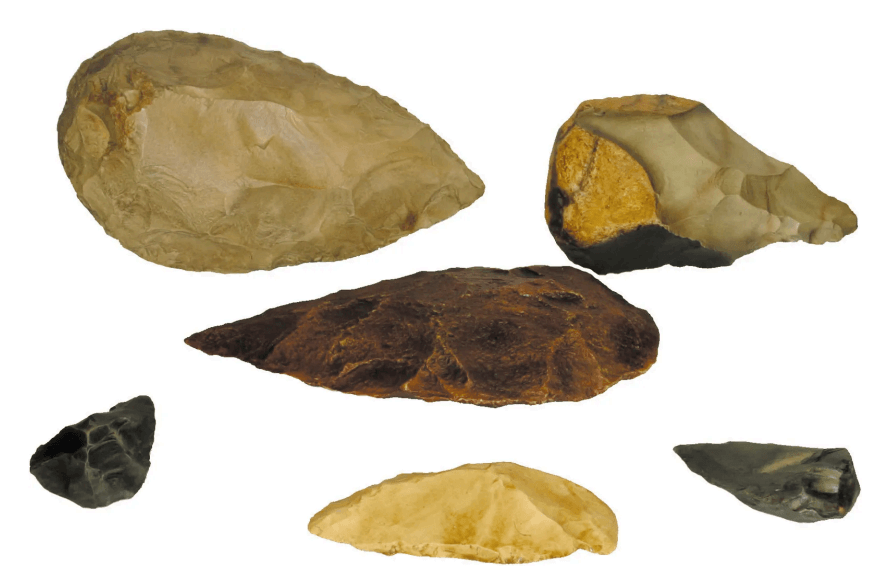
- It is also called the Early Old Stone Age.
- Special characteristic stone tools – Handaxe and clever.
- Key tools : Acheulean-Handaxes, Cleavers, Chopper – Chopping, Scraper, Blade, Simple flakes
- Raw materials used for making stone tools included – quartzite, quartz and basalt
- The sites of early stone age discovered in Rajasthan have been identified as belonging to Acheulian culture, named after French site of St. Acheul which was the first effective colonization of the Indian subcontinent
- The Acheulian culture was a hunter-gatherer culture.
- Major Sites : Budha Pushkar, Jayal(Nagaur), Didwana, Indragarh (Bundi), Viratnagar (Jaipur), Goga Kheda (Rajsamand)
2. Middle Palaeolithic :
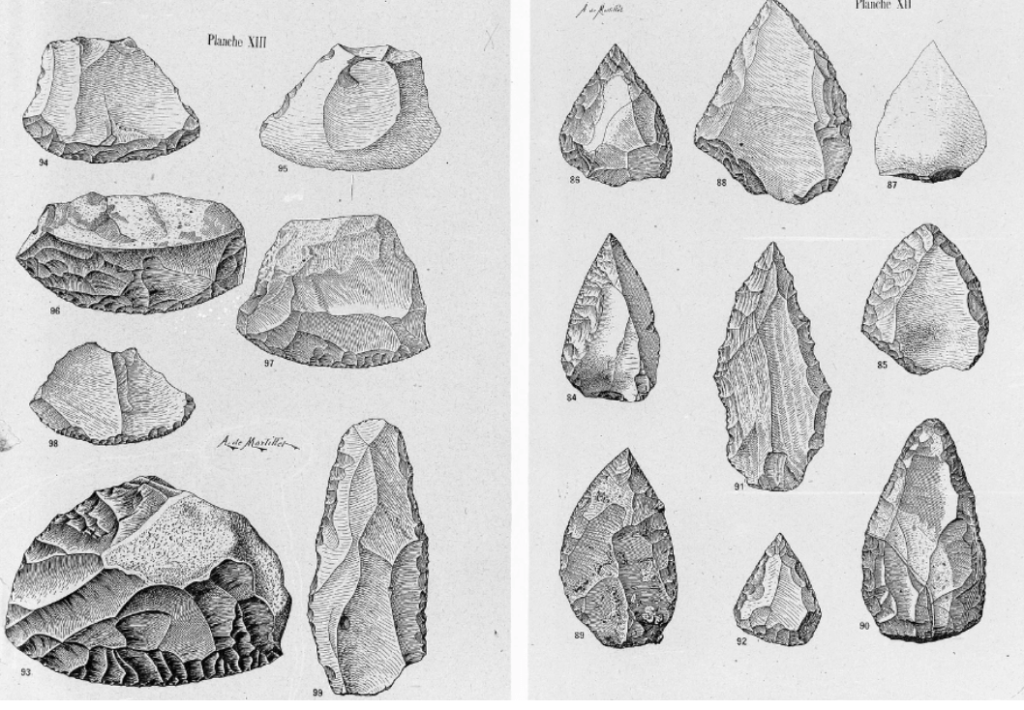
- Time : 1,00,000 BC – 40,000 BC
- The Acheulian culture of old stone age was slowly transformed into the middle Palaeolithic by giving some of the tool types and by developing new tools & technology.
- Special characteristic of stone tools – Flakes
- Key tools : Side scrapers, end scrapers, points, borers, flakes and Blades.
- In comparison to the lower Palaeolithic era, the tools in the middle Palaeolithic became smaller, thinner and lighter.
- New raw materials used for making stone tools included fine-grained siliceous rocks like chert and jasper.
- Major Site : Luni valley, around Didwana, Budha Pushka
3. Upper Palaeolithic :
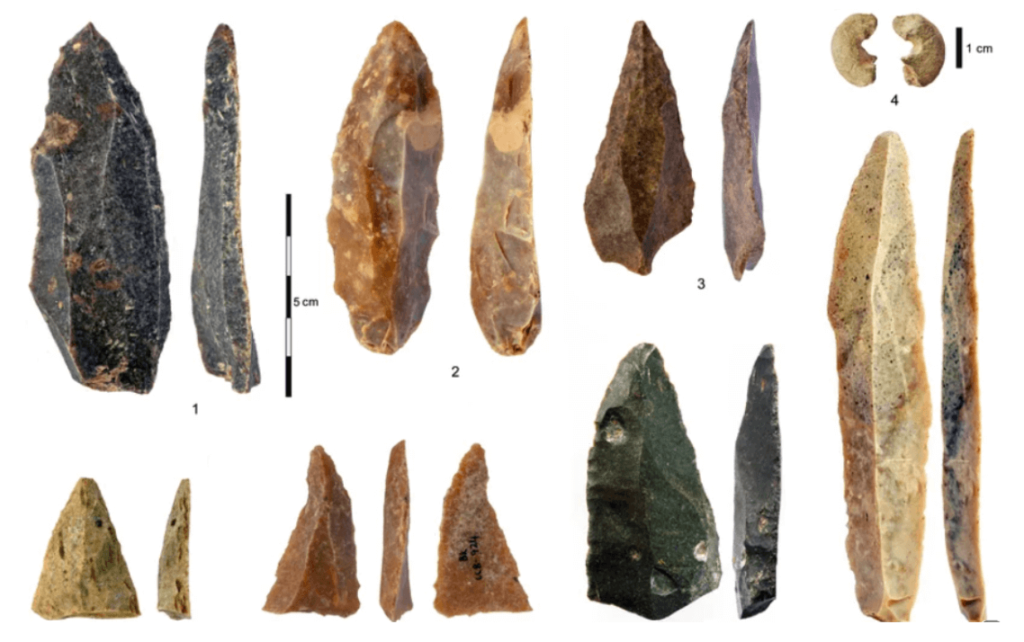
- Time – 40,000 BC – 10,000 BC
- The tools of the Upper Palaeolithic Era are further refined upon the lower and middle periods and show a marked regional diversity with respect to the refinement of techniques and standardization of finished tool forms.
- Special characteristic of stone tools of Upper Palaeolithic age – Flakes and blades
- One important discovery is of the Ostrich egg shells at over 40 sites in Rajasthan, Madhya Pradesh and Maharashtra, which shows that ostrich, a bird adapted to arid climate.
- Society was ‘Band Society‘ – small communities, usually consisting of less than 100 people. They were nomadic to some extent moving from one place to another.
- The earliest form of art by humans also belongs to the upper Palaeolithic period in the form of rock paintings (Bhimbetka).
- Sites of Upper Palaeolithic age in Rajasthan included Chittorgarh, Kota and basins of rivers Wagoon, kadamli, Sabarmati & Mahi.
Major Palaeolithic sites
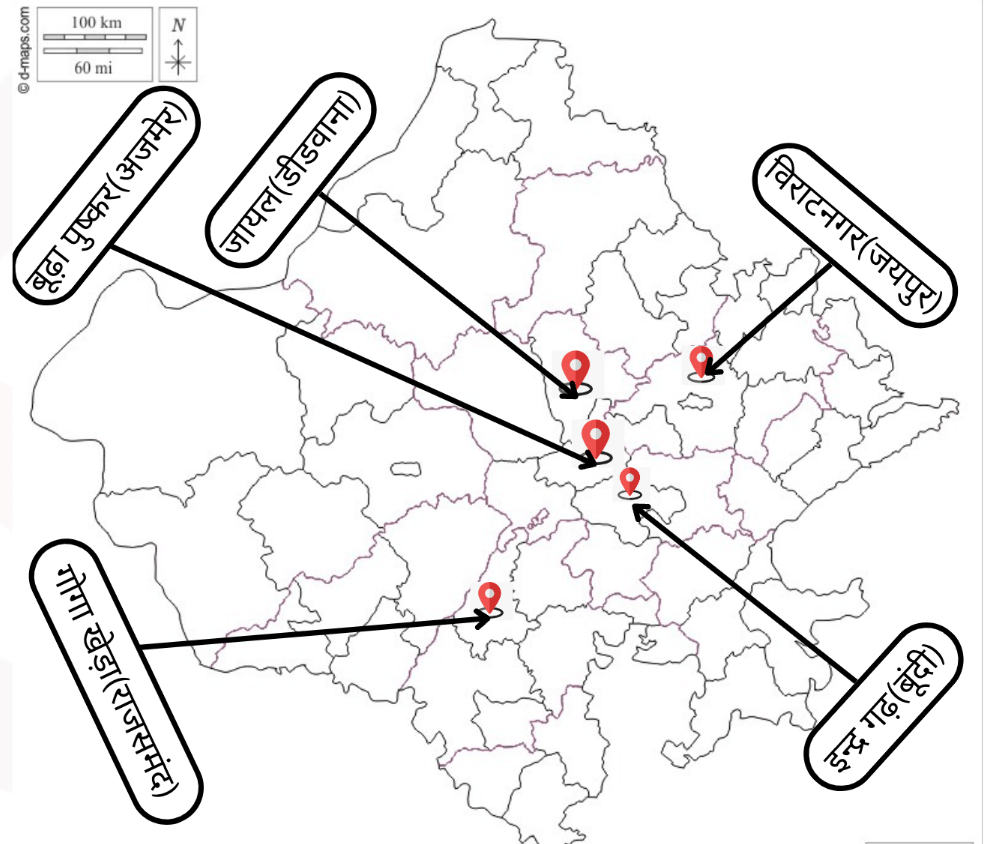
Mesolithic – Middle Stone Age in Rajasthan
- Time : 10,000 BC – 5,000 BC
- The transition from the Palaeolithic period to Mesolithic period is marked by transition from Pleistocene period (2.58 million years ago – 10,000 BC) to Holocene (10,000 BC – till now) and favorable changes in the climate.
- The climate became warmer and humid and there was expansion of flora and fauna contributed by increased rainfall. This led to availability of new resources to humans.
- Tools :
- smaller in size and better in finishing (more geometric) than the Palaeolithic age and are called Microliths.
- Main Tool types – Backed blades, Obliquely truncated blades, Points, Crescents, Triangles and Trapezes
- Some of the microliths were used as components of spearheads, arrowheads, knives, sickles,harpoons and daggers.
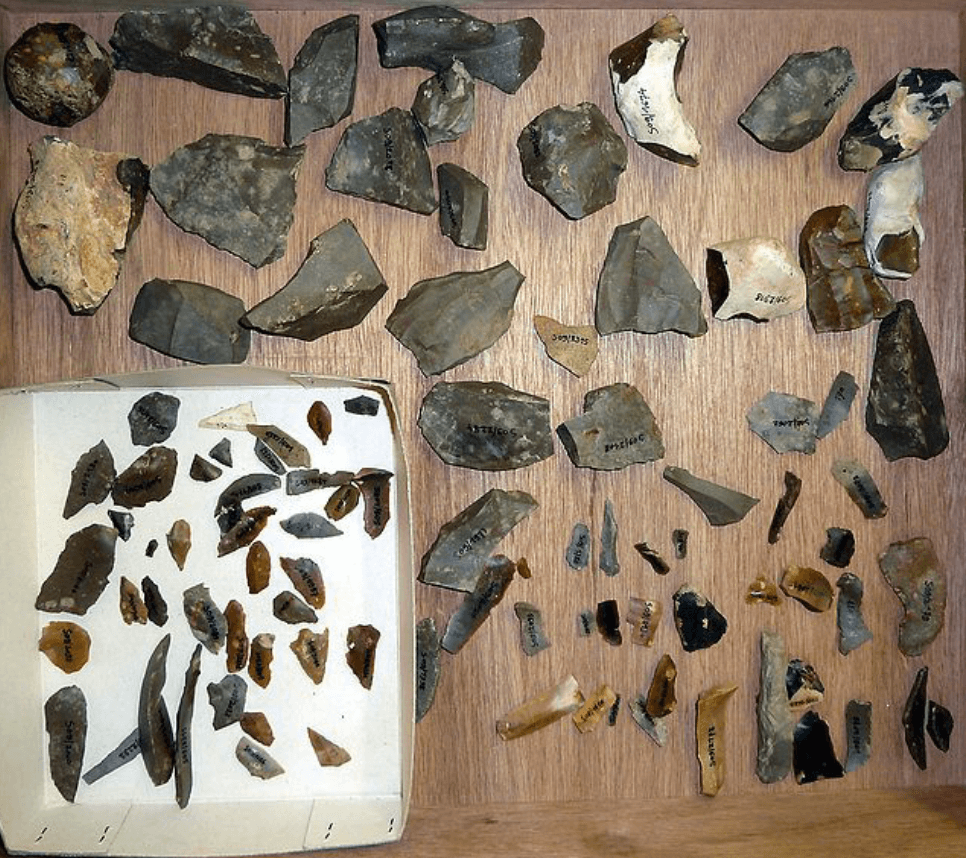
Changes in Society of Mesolithic Age:
- Domestication of animal & Farming :
- The early period of Mesolithic age was based on hunting, fishing and food gathering, slowly domestication of animals, cultivation of crops made their way into human life.
- Earliest evidences of domestication
- India – Adamgarh (M.P)
- Rajasthan – Bagor
- First animals to be domesticated – dog, cattle, sheep and goat.
- First crops to be cultivated were wheat and barley.
- Nomadism to Sedentary settlements :
- favourable climate, better rainfalls, warm atmosphere and increased food security led to reduction in nomadism to seasonally sedentary settlement and increased population.
- First human colonization of the Ganga plains
- Beginning of customs :
- The mesolithic age saw the beginning of the tradition of various ways of intentional disposal of the dead.
- Mesolithic human burials have been found at Bagor in Rajasthan, Langhnaj in Gujarat, Bhimbetka in Madhya Pradesh etc.
- Emergence of Arts :

- The rock painting of the Mesolithic period is found in Adamgarh, Bhimbetka of Madhya Pradesh and Pratapgarh, Mirzapur of Rajasthan.
- The paintings are made mostly in red and white pigments, made from the nodules found in rocks and earth. (Red made by minerals of iron oxide and white by limestone)
- Subject matter of the paintings – mostly wild animals and hunting scenes, some related to human social and religious life.
Mesolithic sites in Rajasthan:
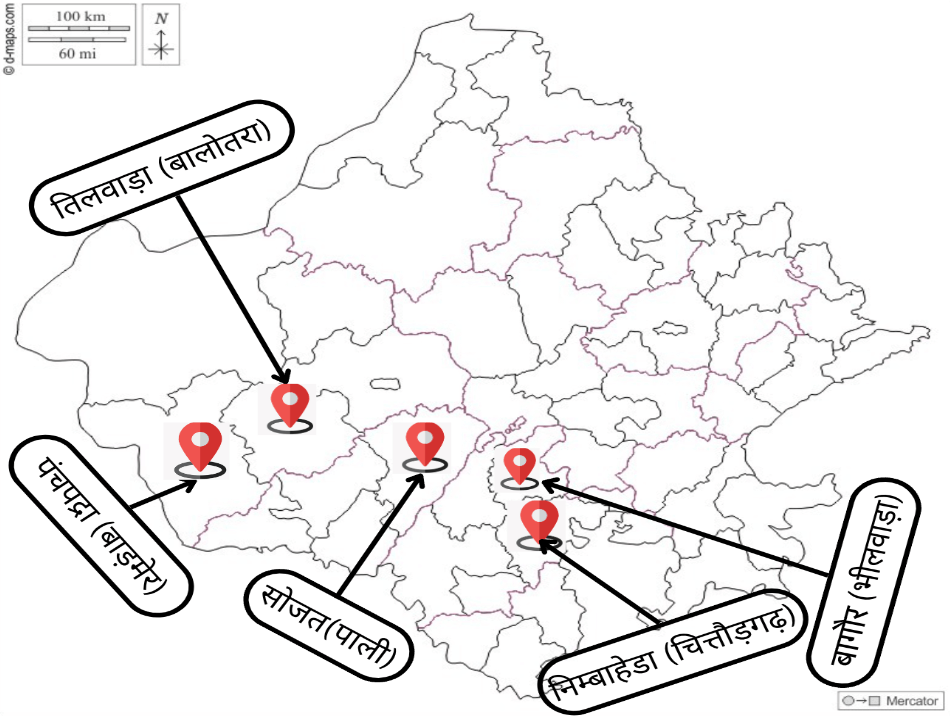
- The Pachpadra basin, Sojat Area & Tilwara of Rajasthan are rich Mesolithic sites and a lot of microliths have been discovered.
- However, Bagor is the largest mesolithic site in India.
Bagore (Bhilwara)
- It is situated on the Mahasati Mound along the banks of the Kothari River in Bhilwara district, Rajasthan.
- Excavations were conducted between 1967 and 1970 under the supervision of Dr. V.N. Mishra and Dr. Lashni.
- The civilization is divided into three levels:
- First Level (4480–3285 BCE): Burials in the east-west direction.
- Second Level (2765–500 BCE): Continued east-west burials.
- Third Level (500 BCE–4th Century CE): Shift in burial orientation to the north-south direction.
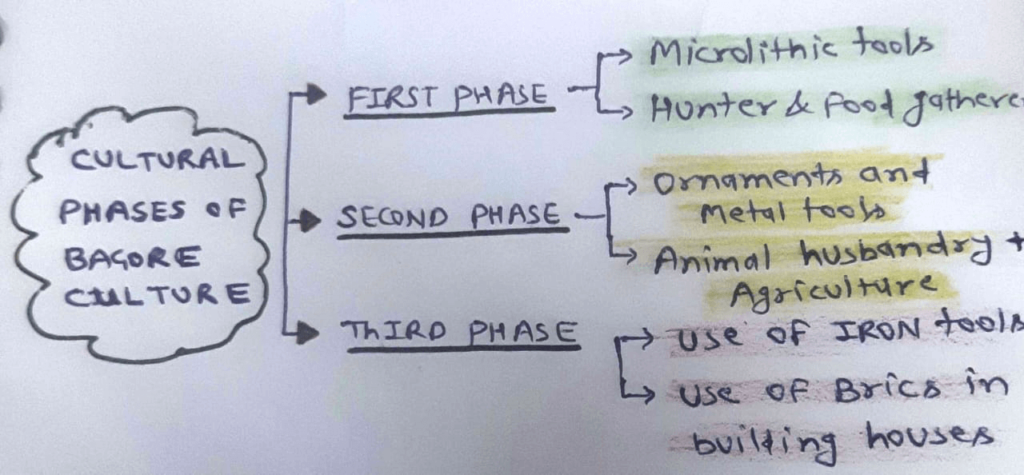
- Features:
- Evidence from the Mesolithic and Neolithic periods.
- Indian subcontinent’s oldest proof of agriculture and animal husbandry.
- Discovery of numerous microlith tools, showcasing a hunter-gatherer lifestyle.
- The tradition of placing food items and pottery with the deceased indicates that the people of this civilization believed in the concept of life after death.
- Finds include bottle-shaped vessels, glass ornaments, and copper tools (notably, the pierced needle).
- Distinct burial customs: east-west alignment in earlier levels and north-south alignment in the later level.
Neolithic – New stone Age in Rajasthan
- Time : 5,000 BC – 1,000 BC
- The Neolithic, which followed the mesolithic age, was the last phase of the Stone age.
- The earliest example is Mehrgarh Culture.
- Neolithic Revolution:
- Mesolithic human settlements got more sedentary.
- People began to settle down in agricultural communities which led to the establishment of villages.
- Now due to surplus food, some people moved away from agriculture and new occupations like dancers , musicians, masonry came up.
- Neolithic tool kit was composed of heavy ground
- Tools – heavy ground tools like pestles, mortars, grinders and pounders.
- Causes of Neolithic Revolution :
- Climatic change at the beginning of the holocene period
- Increasing population density
- Evolving cultural and technological
- The use of pottery and the wheel and the subsequent invention of crafts like spinning, weaving and bead making demonstrate the uniqueness of the neolithic phase.
- Major sites : Viratnagar (Jaipur), Hammirgarh (Bhilwara), Bharni (Tonk), Sohanpura (Sikar), Harsaura (Alwar), Samdari (Barmer), Alaniya (Kota)
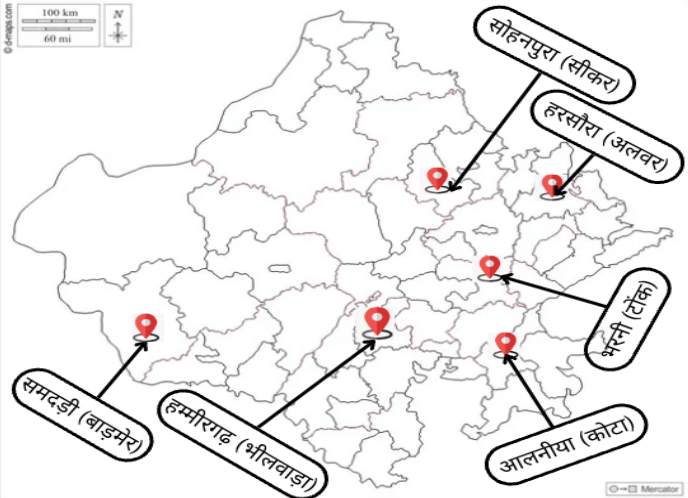
- Features of Mehrgarh Neolithic Culture:
- located on the bank of the Bolan River.
- Considered as the oldest agricultural settlement in the Indian subcontinent.
- Houses made in mud and mud-bricks, created rooms to store grains.
- Domesticated cotton for the first time
- The first evidence in human history for the drilling of teeth in a living person was found in Mehrgarh
Chalcolithic Culture in Rajasthan
The Chalcolithic culture, also known as the Copper Age, refers to the period when humans first started using copper tools along with stone tools. This period comes after the Neolithic Age (Stone Age) and before the Bronze Age. however, Many sites show direct evidence of transition from the Mesolithic to the Chalcolithic period, e.g., Bagor
- This period marks the beginning of permanent rural settlements in Rajasthan.
- Features:
- Pottery: Decorated pottery began during this era, often painted with intricate designs.
- Construction: Chalcolithic people did not use baked bricks.
- Animal Husbandry: Animals were domesticated primarily for meat, not for dairy purposes.
- Writing: There is no evidence of literacy or writing skills among these people.
- Major Chalcolithic Sites in Rajasthan:
- Ganeshwar (sikar)
- Rangmahal (Hanumangarh)
- Ahad (Udaipur)
Rangmahal (Hanumangarh)
- It is Situated on the banks of the Ghaggar River.
- Excavated by a Swedish team from Lund University, including archaeologists Hanna Rydh and Holger Arbman (1952–54).
- Discoveries:
- Artifacts: Bells-shaped pottery, spouted jars, cups, bowls, lids, lamps, and incense burners.
- Coins: A total of 105 copper coins have been discovered, including punch-marked coins and
- coins from the reigns of Kanishka I and Kanishka III.
- Terracotta Figurines: Includes teacher-student figures, Gandhara-style sculptures, and children’s toys like a small clay wheeled cart.
- Krishna Leela Evidence: Earliest depictions related to Lord Krishna’s life.
Bronze Age Culture in Rajasthan
The Bronze Age in Rajasthan represents a transitional phase where the use of copper and bronze significantly altered the way people lived and worked. This period is marked by the rise of complex societies, advanced technologies, and early urbanization. The Bronze Age culture in Rajasthan is closely associated with early urban centers along rivers like Ghaggar and Chautang.
- Time: 3000 BCE to 1500 BCE
- Features:
- Urbanization and Settlement:
- People began living in more organized and densely populated settlements.
- Evidence suggests the growth of permanent settlements and early forms of town planning.
- Society and Economy:
- The period saw development of social stratification.
- The economy was based on agriculture, animal husbandry, and craft production.
- Technology and Tools:
- Early forms of copper and bronze tools were used.
- The discovery of the wheel and the first writing system marked major technological advancements during this era.
- Pottery and Artifacts:
- Red and black ware with intricate geometric designs
- Important Sites:
- Urbanization and Settlement:
Sothi (Bikaner):
- Excavator: Luigi Pio Tessitori, excavated under the guidance of Amalanand Ghosh.
- Location: Near Ghaggar and Chautang Rivers.
- Known as Kalibanga I; its remains are found in Rajasthan, Haryana, and Punjab.
Iron Age Culture in Rajasthan
The Iron Age in Rajasthan saw a significant leap in technological advancements, with the use of iron tools replacing bronze and copper. This period is also marked by the rise of powerful kingdoms
Features:
- Agriculture and Settlements:
- Transition towards more organized agriculture with evidence of ploughed fields, and fortified settlements, People raised cattle and grew crops like wheat and barley.
- Pottery: Red Ware with distinctive patterns, often associated with later Vedic culture.
- Important Sites:
Bairath (Jaipur):
- Excavator: Initially discovered by Captain Burt in 1837, later excavated by Daya Ram Sahni in 1936-37.
- Location: Bān Ganga River.
- Key Features:
- Matsya Mahajanapada’s capital was at Viratnagar or Bairath.
- Bhabru Rock Edict: Found by Captain Burt, this inscription uses Shankha script and mentions Emperor Ashoka’s conversion to Buddhism.
- Bairath Temples: Excavations uncovered a Buddhist circular temple and inscriptions dating back to Shaka Samvat (1509).
- Mughal Influence: Akbar’s general, Man Singh, built a Mughal Gate and a garden here.
- Bairath has yielded significant remains from the Stone Age to the post-Gupta period.
- During the Stone Age, evidence of cave paintings created using the petroglyph technique has been found, depicting elephants, bears, deer, and other figures.
- In the Copper Age, this region extended to Bairath, Cheethwadi, and Kiradot, while
- in the Iron Age, it expanded to Jodhpura and Sunari. Bairath was the center of the Matsya Mahajanapada, where the Pandavas spent their period of exile.
- During the Maurya period, it became a major center of Buddhism, as evidenced by Ashoka’s Bhabru inscription. In 1999, a circular temple was discovered here, considered one of the oldest temples in India.
- During the Gupta period, Bairath was under the Gupta Empire, and in 634 CE, Chinese traveler Xuanzang referred to it as “Parayatra.” During the Mughal period, it housed a royal mint, with coins bearing the inscription “Bairath.”
Noh (Bharatpur):
- Location: 6.43 km from Bharatpur on the Agra road.
- Iron Age site, excavated by R.C Agarwal.
- Excavations: Revealing fortified settlements, pottery, copper tools, iron implements, and terracotta figurines, Large Stone idol of Yaksha.
Sunari (Neemkathana):
- Iron smelting furnaces and evidence of chariot-making.
Raidh (Tonk):
- A large number of iron tools have been found from this site, due to which this site is called The Tata Nagar of ancient India.
- 3075 punch-marked coins have been found from this archaeological site. Among these coins, the coins of Malwa, Mitra rulers, Indonesian coins and the broken coin of Greek ruler Apollodotus are prominent.
- Remains of 115 Chakrakups have been found from this site.
- Malva Janapada is inscribed on the lead coin found from this site, which proves that this area was under the control of Malava Janapada.
- Boxes made of alabaster (similar to the boxes of Buddhist monks) have been found from this site.
Indus Valley Civilization (3500 – 2500 BC)

- Indus Valley Civilization existed between 3300-1600 BC in three phases namely early, mature and late phases. It was discovered in 1921 and belonged to the Bronze Age. Indus Valley Civilization was located on the banks of the river Indus.
- Major Sites : Dholavira , Rangpur, Rojdi, Lothal, Surkotada , Kuntasi, Padri (Gujarat) Kalibangan (Rajasthan), Bhagwanpura, Banawali (Haryana), Diamabad (Maharashtra), Alamgirpur (U.P.), and Manda (Jammu)
- The most unique feature of civilization was the development of Urban Centers.
- Architecture Snapshot : Mohenjodaro Site
- The settlement is divided into two sections; Citadel and the Lower Town.
- Citadel has structure most probably used for special public purposes
- ‘Granaries’ which were used to store grains
- ‘Great Bath’ – public bathing place shows the importance of ritualistic bathing
- Evidence of buildings of big dimensions which perhaps were public buildings, administrative or business centers.
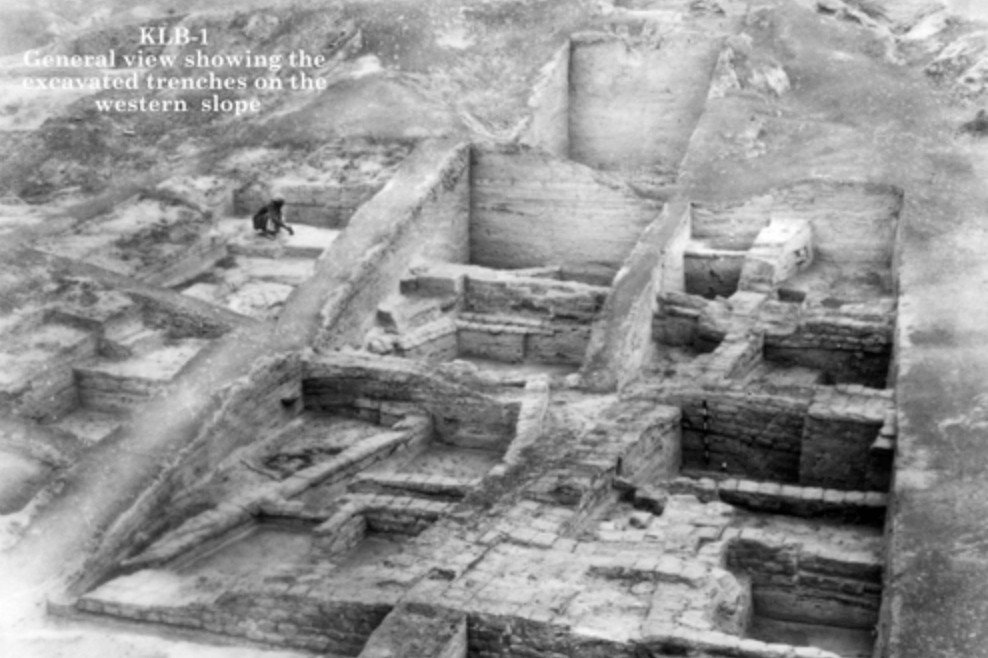
- Lower Town
- It was walled, probably to provide security to the people
- Rectangular grid pattern of layout with roads that cut each other at right angles.
- Used standardized burnt mud-bricks as building material
- Domestic Architecture:
- Present in Lower Town.
- Most of the houses had private wells and bathrooms. The bathrooms had drains connected through walls to the street drains.
- Many of the houses were centered on a courtyard with rooms on all sides.
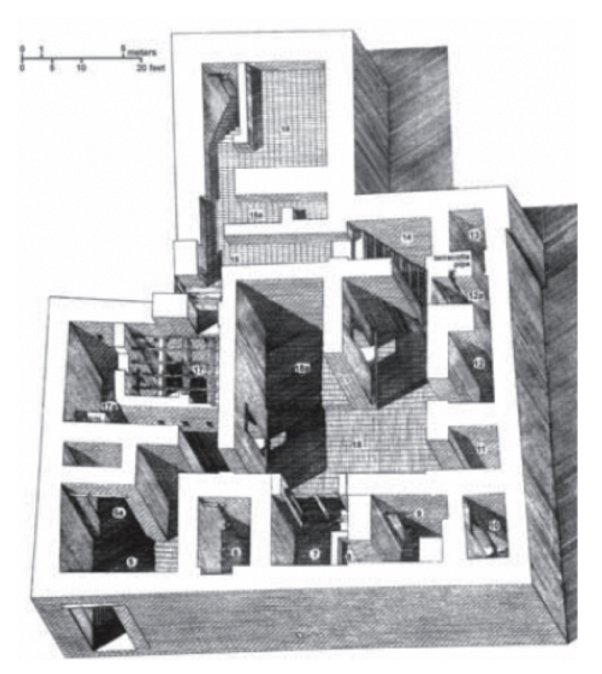
Indus Valley Sites in Rajasthan:
- Kalibangan
- Baror
- Karanpura
Kalibangan
- Kalibangan is a part of the ancient Indus Valley Civilization, located in present Hanumangarh district.
- The site was discovered by Luigi Pio Tessitori, an Italian Indologist and linguist. After Independence in 1952, Amlānand Ghosh identified the site as part of Harappan Civilization and marked it for excavation. Later, during 1961-69, excavations were carried out by B. B. Lal & Balkrishna Thapar.
- Kalibangan has settlements belonging to :
- Pre-Harappan Period from the 3500 BC – 2500 BC
- Harappan Period from the 2500 BC – 1500 BC

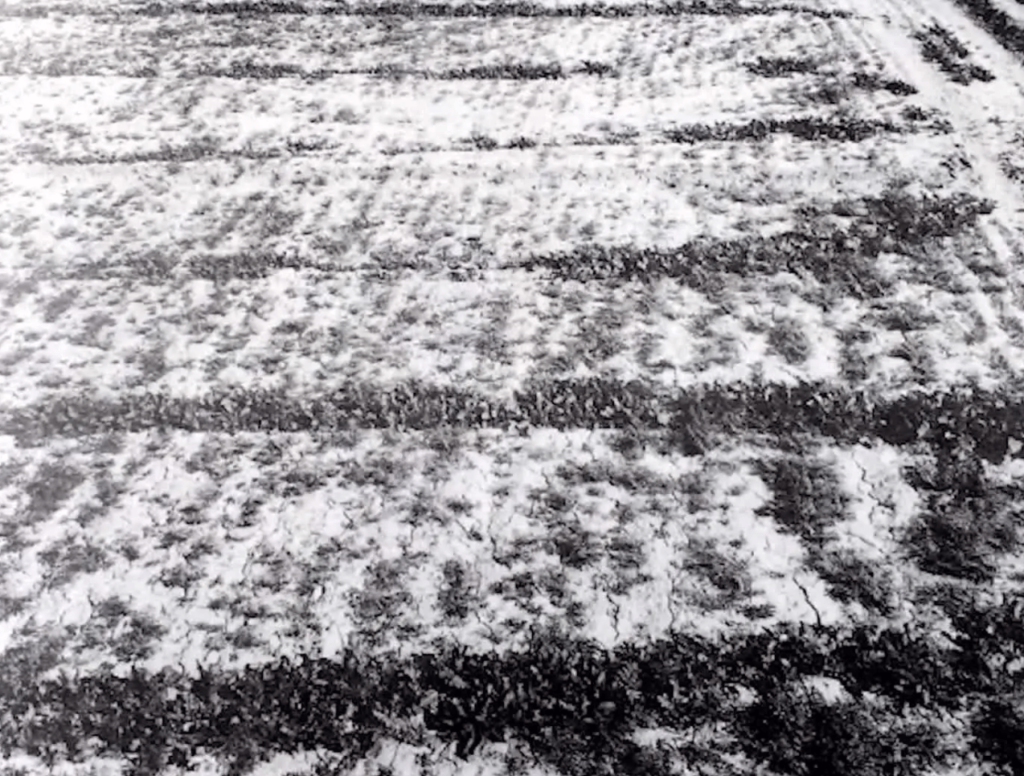
Features of Pre-Harappan Settlement :
- Pre-Harappan settlement was a fortified parallelogram, the fortification wall being made of mud-bricks.
- The houses within the walled area were also made of mud-bricks.
- The distinctive trait of this period was the pottery which was significantly different from that of the succeeding Harappans.
- Settlement outside the town-wall. This is perhaps the earliest ploughed field excavated so far.
- An outstanding discovery was a ploughed field,showing a cross-grid of furrows, the southeast of the settlement outside the town-wall. This is perhaps the earliest ploughed field excavated so far.
Features of Harappan Period :
Town Planning:
- During the Harappan period, the structural pattern of the settlement was changed. There were now two distinct parts:
- The citadel on the west and the Lower city on the east.
- The citadel was situated on a higher level and looked like a fortified parallelogram (mud bricks). It was further divided into 2 parts: Northern half (contained residential buildings of the elite) and Southern half (contained some five to six massive platforms for religious purpose).
- The lower city was also fortified and within the walled city, there was a grid of streets running north-south and east-west, dividing the area into blocks. The houses were built of mud-bricks, baked bricks being confined to drains, wells, sills, etc.
- Beside the above two principal parts of Kalibangan, there was also a third one, situated 80 m east of the lower city. It consisted of a modest structure, containing four to five ‘fire-altars’ and as such could have been used for ritualistic purposes.
Burial:
- The cemetery of the Harappans was located to the southwest of the citadel.
- Three types of burials are found
- Extended inhumation in rectangular or oval grave-pits.
- Pot-burials in a circular pit.
- Rectangular or oval grave-pits containing only pottery and other funerary objects.
Terracotta:
- The best terracotta figure from Kalibangan is that of a charging bull which is considered to signify the “realistic and powerful folk art of Harappan Age”.
Seals:
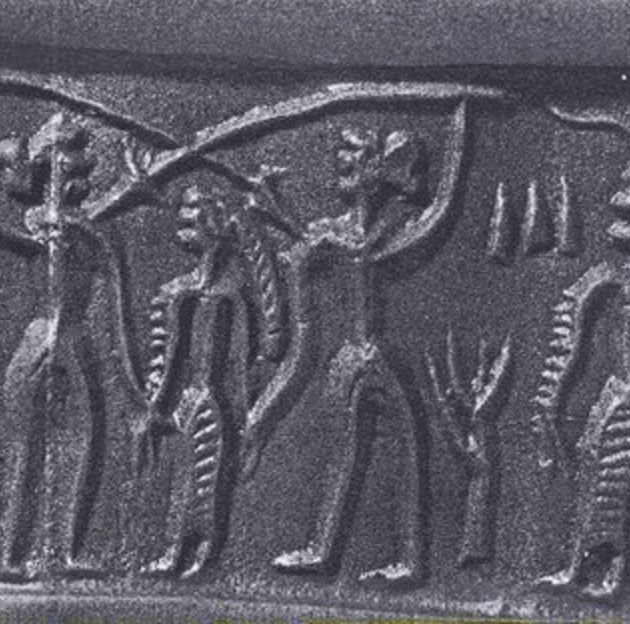
- Most noteworthy is a cylindrical seal, depicting a female figure between two male figures, fighting or threatening with spears.
Pottery:
- Black-Red pottery
Kalibangan artifacts
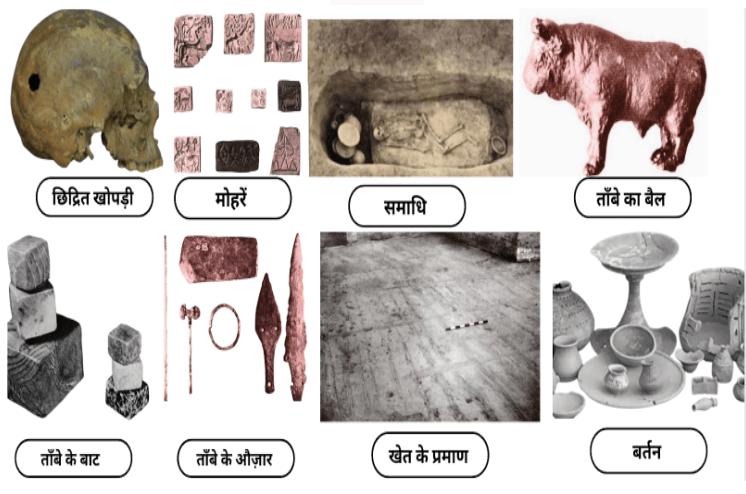
Ahar-Banas Culture of Rajasthan
- Time : 3000 to 1500 BCE
- Excavated by: 1953- A.k. vyas,1956- R.c agarwal, 1956- H.d sankalia
- The Ahar culture, also known as the Banas culture, is a Chalcolithic Culture of southeastern Rajasthan.
- It was contemporary and adjacent to the Indus Valley Civilization and the main distribution of this culture seems to be concentrated in the river valleys of Banas and its tributaries namely Bedach and Ahar.
- More than 90 sites (Gilund, Ahar, Ojiyana and Balathal etc) of the culture have been identified till date which provide important information about the transformation of life from hunting-gathering to agriculture in the Mewar region.
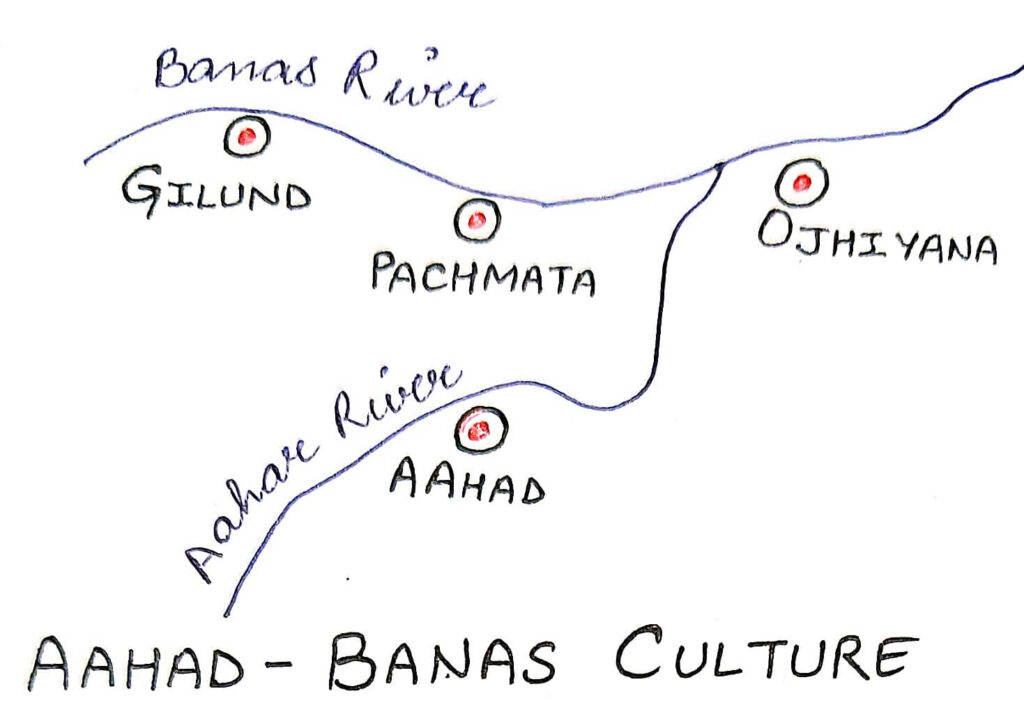
Features of Ahar-Banas Culture:
- Houses:
- People lived in single, double & multi-roomed rectangular, square or circular houses.
- The houses were made of stones, mud bricks, the walls being plastered with mud.
- Pottery:
- Typical Ahar pottery is a Black-and-Red ware (BRW) with linear and dotted designs painted on it in white pigment and has limited range of shapes, which include bowls, bowls-on-stands,
- elongated vases and globular vases.
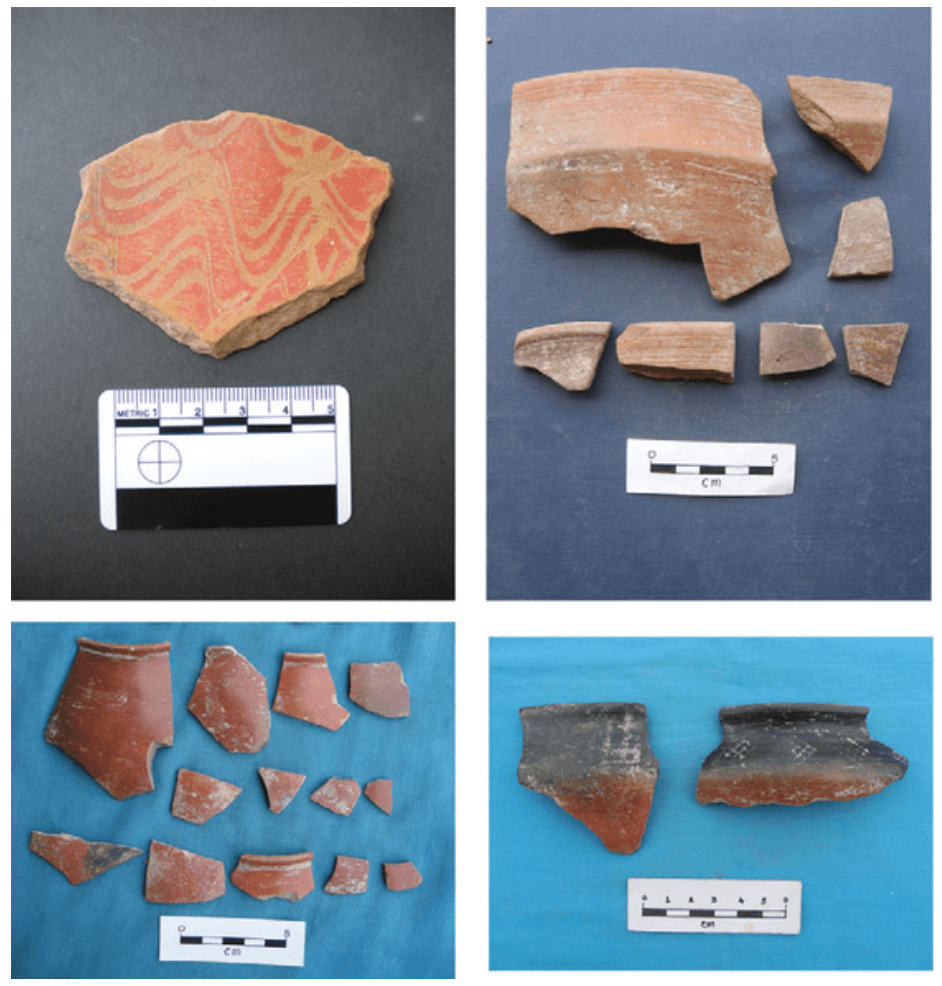
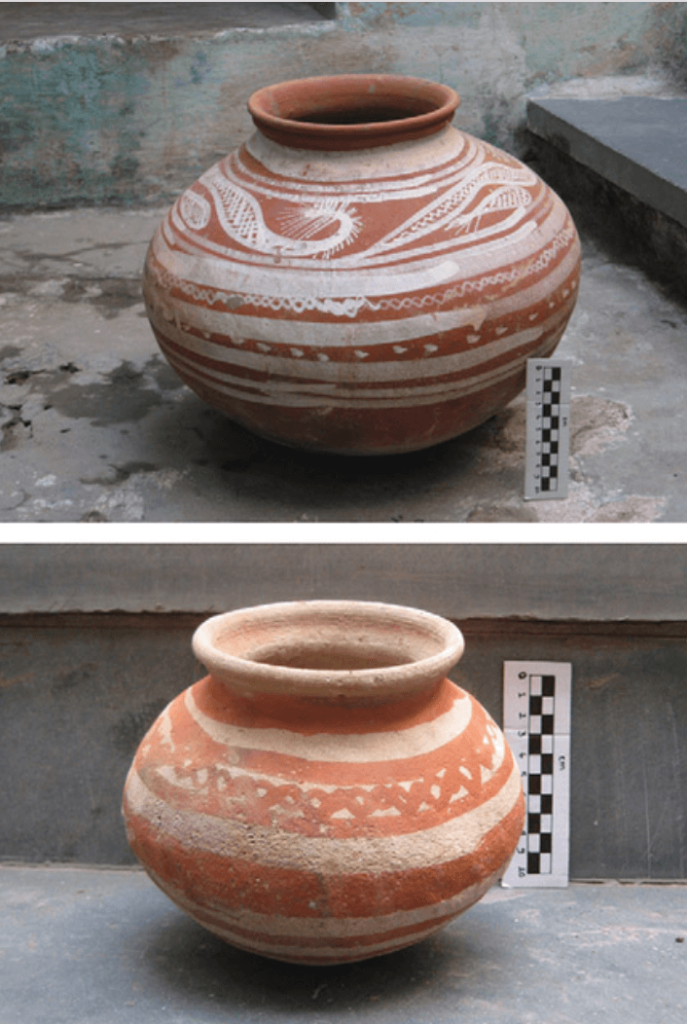
- Economy & Subsistence:
- Based on cultivation, animal rearing and hunting, sustained on a number of crops, including wheat and barley.
- People of Ahar culture had trade links with the Harappans.
- Technology:
- The technology of the Ahar people was mostly based on copper that is why Ahad was called by the name of ‘Tamravati’.
- They exploited the copper ores of the Aravalli Range to make axes and other artefacts.
- However, the Neolithic trend of using polished stone tools continued in this period also and microlithic tools of siliceous material were also very common.
- Important Sites:
- Gilund
- Ahar
- Ojiyana
- Balathal
- Pachamta (Because, Excavation done in 2015)
Difference Between Civilization and Culture
To understand the difference, let’s start with the words “Indus Valley Civilization” and “Ahar-Banas Culture.” Notice how we call one a civilization and the other a culture.
- What is Culture ?
- Culture refers to the way of life of a group of people. It includes their traditions, beliefs, art, language, and rituals.
- Example: The Ahar-Banas Culture was a small community in Rajasthan known for its pottery, agricultural practices, and burial customs. It did not have advanced cities or organized governance, so it is called a culture, not a civilization.
- Culture can exist without civilization. For example, early humans in prehistoric times had a culture (tools, cave paintings, and rituals) but no civilization.
- What is Civilization ?
- Civilization is an advanced and organized stage of human society. It includes not just culture, but also technology, governance, economy, and infrastructure.
- Example: The Indus Valley Civilization had well-planned cities like Mohenjo-Daro and Harappa, advanced drainage systems, trade networks, and governance.
- Culture forms the foundation of every civilization. For example, the people of the Indus Valley built their civilization on shared cultural practices—such as art, religious beliefs, and daily traditions.
So, we can say that culture is the seeds and civilization is the tree.
Gilund (Rajsamand)
- Gilund is an archaeological site in Rajsamand district on the bank of Banas River which is part of Ahar-Banas chalcolithic culture.
- Excavation carried out at the site during 1959-60 by B.B.Lal revealed two mounds labelled as ‘Eastern’ and ‘Western’ mounds.
- Features:
- Gilund was occupied from approximately 3000-1700 BCE. These years of occupation can be divided into two Periods:
- Early Ahar-Banas culture 3000-2000 BCE.
- Late Ahar-Banas culture 2000-1700 BCE
- Early Ahad-Banas period of Gilund:
- It was chalcolithic in character.
- Residential houses are made of mud brick, the walls being plastered with mud
- Pottery: Black and Red Ware (BRW)
- Terracotta figurines: bull figurines with a prominent hump and long horns.
- Late Ahad-Banas period of Gilund:
- Period II of Gilund seems to have begun about the middle of the 1st millennium B.C., as indicated by the presence of bowls and dishes of grey ware.
- In the successive strata have been found Sunga and Kushana bowls in red ware, sprinklers in the Red Polished Ware, bowls in kaolin ware and knife-edged bowls in red ware, indicating that this occupation continued up to the end of the 1st millennium A.D.
Balathal (Udaipur)
- Excavated by: 1962-63 Virendra Nath Mishra
- This ancient site was occupied during two cultural periods:
- The Chalcolithic period (3000 BC to 1500 BC)
- The Early Historic period (5 -3 century BC)
Chalcolithic Phase:
- Balathal was part of the Ahar-Banas Complex and shares similarities with other Ahar-Banas sites based on the artifacts discovered during excavations.
- This period features well-planned structures. Archaeologists found square or rectangular houses at the site, built with mud bricks and stones.
- Objects: saddle querns, mullers, rubber stone, hammer stone and copper objects including choppers, knives, razors
- Researchers concluded that the people followed an agro-pastoral lifestyle, combining farming with animal herding.
- After the Chalcolithic period, the community abandoned the site for a long time until it was reoccupied in the Early Historic period.
Early Historic Phase: (Iron age)
- Excavation of the early historic phase produced the evidence (remains of 5 Iron smelting furnaces) of large-scale use of iron implements, suggesting its important role in the economy of that period.
- The people lived in wattle and daub houses and the floors were made of mud and stone rammed together.
- Kalibangan
Most peculiar item from Balathal :
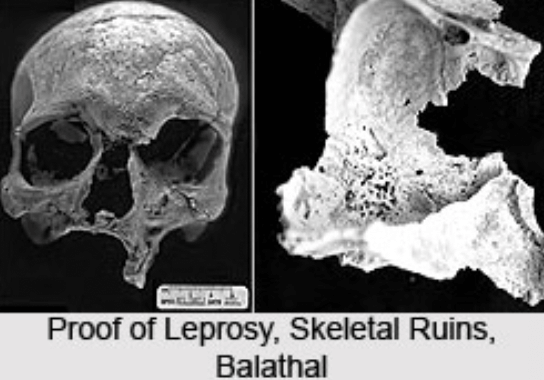
A skeleton was found buried at Balathal believed to be the 4,000 year old skeleton of a man believed to be 37 years old when he died. The skeleton provides the oldest evidence of leprosy in human beings.
Pachamta
- Recently in 2015, excavations were carried out at Pachamta, a village 100 km from Udaipur in Rajasthan, under a project called the Mewar Plains Archaeological Assessment.
- Pachamta belongs to the Ahar-Banas culture, which was contemporaneous with the early and mature Harappan culture.
- Artefacts such as perforated jars, shell bangles, terracotta beads, shells and the semi-precious stone lapis lazuli, different types of pottery and two hearths have been found during excavation.
OCP Culture of Rajasthan
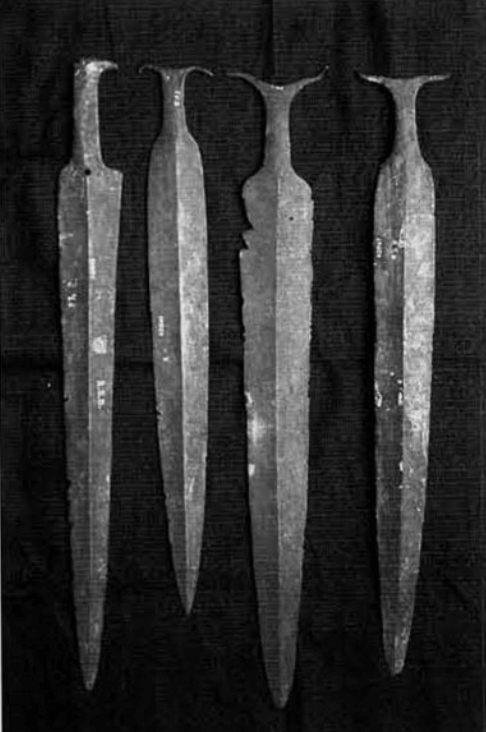
- The Ochre Colored Pottery (OCP) culture is a Bronze Age culture (2000–1500 BCE) known for its distinct red or ochre-colored pottery.
- Features:
- Pottery:
- Red or ochre-colored with a red slip; gave an ochre stain to fingers when touched.
- Similar to Late Harappan and Vedic pottery styles.
- Copper Hoards:
- Found with copper tools like axes, weapons, and other artifacts, giving it the nickname Copper Hoard Culture.
- OCP settlements are small in size and have thin habitation deposits. This indicates that habitation on them was of short duration.
- Lifestyle and Economy: agriculture(Rice, barley, and legumes) with animal husbandry (Domesticated cattle, sheep, goats, pigs).
- Pottery:
- In Rajasthan, Ochre Colored Pottery sites have been discovered at:
- Ganeshwar (Sikar)
- Jodhpura (Jaipur)
Ganeshwar (Sikar)
- Ganeshwar is a copper culture site discovered at the source of river Kantali at Neem ka Thana in Sikar district.
- Excavated by: 1972- R.C Agarwal
- A large number of painted OCP (Ochre Coloured Pottery) pot sherds decorated with patterns in black colour have been found.
- Ganeshwar is located near the copper mines (Khetri) and It mainly supplied copper objects to Harappa.
- 99% of the metals discovered from here are copper which includes needles, spears, arrowheads, hairpins, fishing hooks etc.
Jodhpura (Jaipur)
- Jodhpura is located in the Kotputli Tehsil of Jaipur district, situated on the banks of the Sabi River.
- R.C. Agrawal and Vijay Kumar directed the excavation at the site in 1972–73.
- The site represents evidence from the Chalcolithic period, as well as the Iron Age, Shunga-Kushan period, and Mauryan period.
- Evidence of OCP Culture:
- A 1.5-meter-thick deposit of Ochre Colored Pottery (OCP) was found.
- The pottery shows influences of the Indus Valley Civilization.
- Jodhpura is a significant site for the Grey Painted Ware Culture as well.
- Evidence of houses with tiled roofs and thatched coverings was found.
Source : Link
FAQ (Previous year questions)
(1) Bagore (2) Kalibangan (3) Ahar
Bagore Location – Mahasati Mound along the banks of the Kothari River in Bhilwara district
Excavations – 1967 and 1970 under the supervision of Dr. V.N. Mishra and Dr. Lashni.
Phases – 1st– Microlithic Tools , Hunting and Food Gathering
2nd– Ornaments and Metal Tools, Animal Husbandry + Agriculture
3rd– Use of Iron Tools, Use of Bricks in building Houses
Features: Evidence from the Mesolithic and Neolithic periods.
Oldest proof of agriculture and animal husbandry.
Believed in the concept of life after death.
Distinct burial customs: east-west alignment in earlier levels and north-south alignment in the later level.
Kalibangan Location – Present Hanumangarh district.
Excavations – Discovered by Luigi Pio Tessitori, Amlānand Ghosh(1952), B.B. Lal & B.K Thapar(1961-69).
Phases – Pre-Harappan Period (3500 BC – 2500 BC) was a fortified parallelogram
Use of Mud Bricks
Evidences of earliest ploughed field
Harappan Period (2500 BC – 1500 BC)
The settlement was divided into 2 Parts- The citadel on the west – fortified parallelogram, further divided into 2 parts
Lower city on the east – fortified and within the walled city, grid of streets, houses were built of mud-bricks
Ahar
Location – Around the Ahar river in the Udaipur district
Excavated – 1953- A.k. vyas,1956- R.C agarwal, 1956- H.d sankalia
Features: Houses – single, double & multi-roomed, made of stones, mud bricks
Pottery – Black-and-Red ware (BRW) with linear and dotted designs painted
Technology – Mostly based on copper that is why Ahad was called by the name of ‘Tamravati’.
Economy & Subsistence – Animal rearing and hunting, sustained on a number of crops, including wheat and barley
